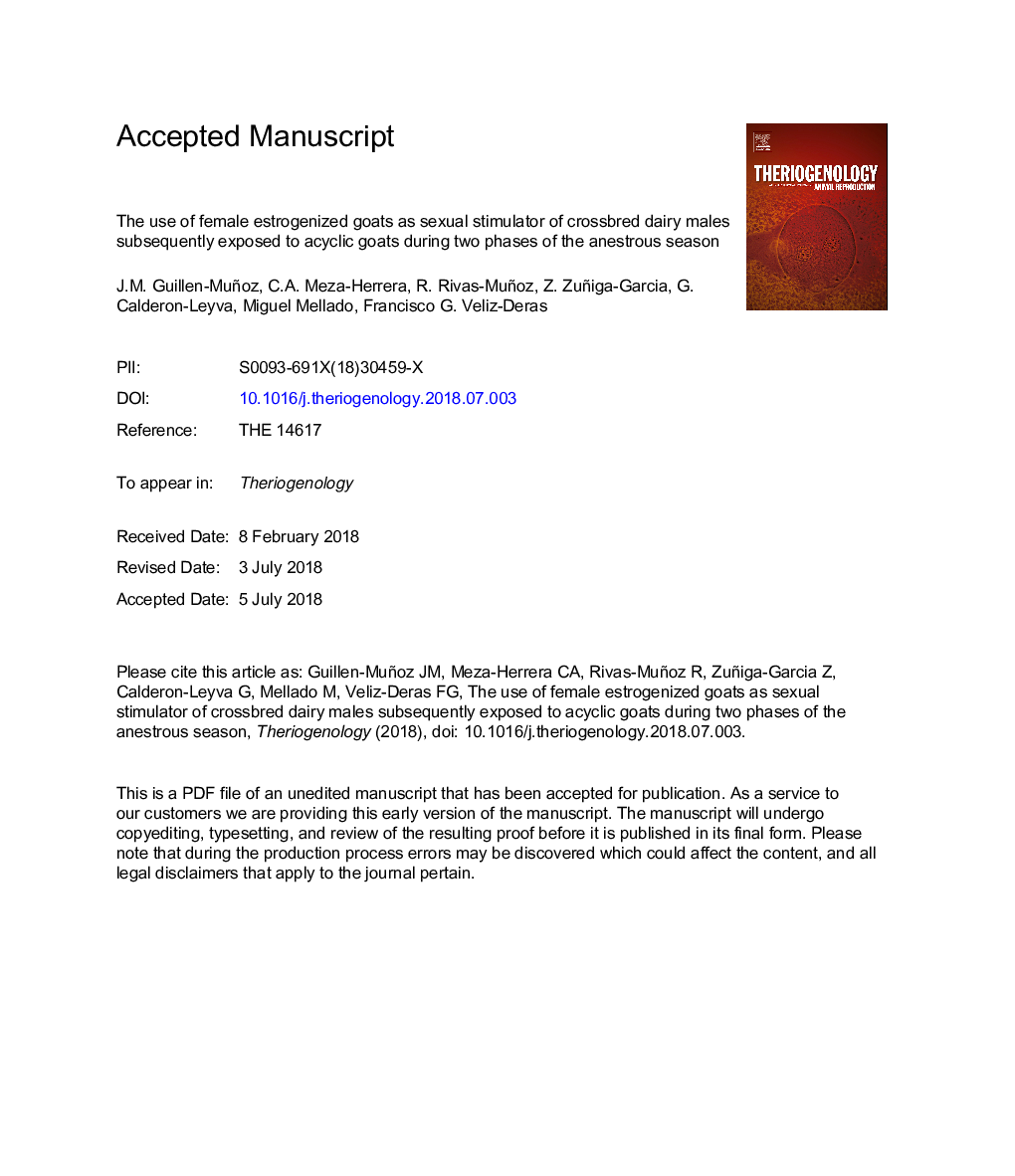| کد مقاله | کد نشریه | سال انتشار | مقاله انگلیسی | نسخه تمام متن |
|---|---|---|---|---|
| 8426278 | 1546050 | 2018 | 31 صفحه PDF | دانلود رایگان |
عنوان انگلیسی مقاله ISI
The use of female estrogenized goats as sexual stimulator of crossbred dairy males subsequently exposed to acyclic goats during two phases of the anestrous season
ترجمه فارسی عنوان
استفاده از بز زنانه استروژنیزه شده به عنوان محرک جنسی از مردان لبنی متقابل، متعاقب آن در طی دو مرحله از فصل آلودگی به بز های آسیلیکلی
دانلود مقاله + سفارش ترجمه
دانلود مقاله ISI انگلیسی
رایگان برای ایرانیان
کلمات کلیدی
بز ها، نژادهای متقابل لبنی، فصل انستروس، اثر زن اثر مردانه، رفتار تولید مثل، عملکرد تخمدان،
موضوعات مرتبط
علوم زیستی و بیوفناوری
علوم کشاورزی و بیولوژیک
علوم دامی و جانورشناسی
چکیده انگلیسی
This research evaluated the possible influence of exposure of male goats to estrogenized female goats (“female effect”) upon males' sexual behavior [appetitive (ASB) & consummatory (CSB)], as well as the induction of reproductive activity of crossbred dairy female goats exposed to such treated males (“male effect”) during the early and deep anestrous periods. Crossbred dairy adult male goats (n = 12; 24-48 mo. old) and 80 anovulatory crossbred dairy adult female goats (34-50 mo. old) were used during two experimental periods: March to April and April to May. First, males were separated into four groups (n = 3 each), roughly homogeneous regarding body weight and body condition score and randomly assigned to four experimental groups. The first two groups included males + estrogenized females, then such males were exposed to anestrous females either during March (group 1: three males; 20 females; EFEM-MAR), or during April (group 2: three males; 20 females; EFEM-APR). The second two groups were respective control groups: Males + non-treated-anestrous females, and then such males exposed to acyclic females either during March (group 3: three males; 20 females; CONT-MAR) or April (group 4: three males; 20 females; CONT-APR). Once the male-to-female contact was established, both odor (ODT) and behavior (BEHT) tests (2 d Ã 2 h) were performed during both anestrous periods. On day 10 after introduction of the males, in both anestrous periods, one ultrasonography scanning (“US”) was performed to quantify the presence, number and size of corpus luteum (US-CL) to determine the effectiveness of the “male effect” and indicators of ovarian activity. Then, on day 45 after introduction of the males, a second US was performed to evaluate pregnancy rate (US-PREG). The EFEM-males, regardless of the phase of the anestrous cycle, had an increased (P < 0.05) odor intensity with respect to the control groups. In addition, while an increased (P < 0.05) ASB occurred in the EFEM-males, no CSB differences (P > 0.05) arose when treatments were compared, neither in March-April nor in April-May. The EFEM-males exposed to acyclic goats in March-April (i.e. early anestrous period), promoted not only the largest estrus and ovulatory responses (P < 0.05), but also the largest pregnancy rate (P < 0.05) in these previously anestrus goats, suggesting that in April-May (i.e. profound anestrous), the presence of active males was not enough to completely suppress cyclic reproductive arrest. This study generates interesting out-of-season reproductive outcomes in a goat population with a large proportion of highly seasonal dairy breeds (i.e. Alpine, Saanen and Toggenburg), augmenting the possibility to expand milk production and the economic income of goat producers across the year. Besides, this practice may serve as an interesting reproductive tool to increase the sustainability of marginal goat production systems under semiarid conditions.
ناشر
Database: Elsevier - ScienceDirect (ساینس دایرکت)
Journal: Theriogenology - Volume 119, 1 October 2018, Pages 175-182
Journal: Theriogenology - Volume 119, 1 October 2018, Pages 175-182
نویسندگان
J.M. Guillen-Muñoz, C.A. Meza-Herrera, R. Rivas-Muñoz, Z. Zuñiga-Garcia, G. Calderon-Leyva, Miguel Mellado, Francisco G. Veliz-Deras,
